Thunderball (film)
7.8 /10 1 Votes
85% Rotten Tomatoes Genre Action, Adventure, Thriller Budget 5.6 million USD | 7/10 IMDb Duration Language English | |||||||||||||||||||||||||||||||||
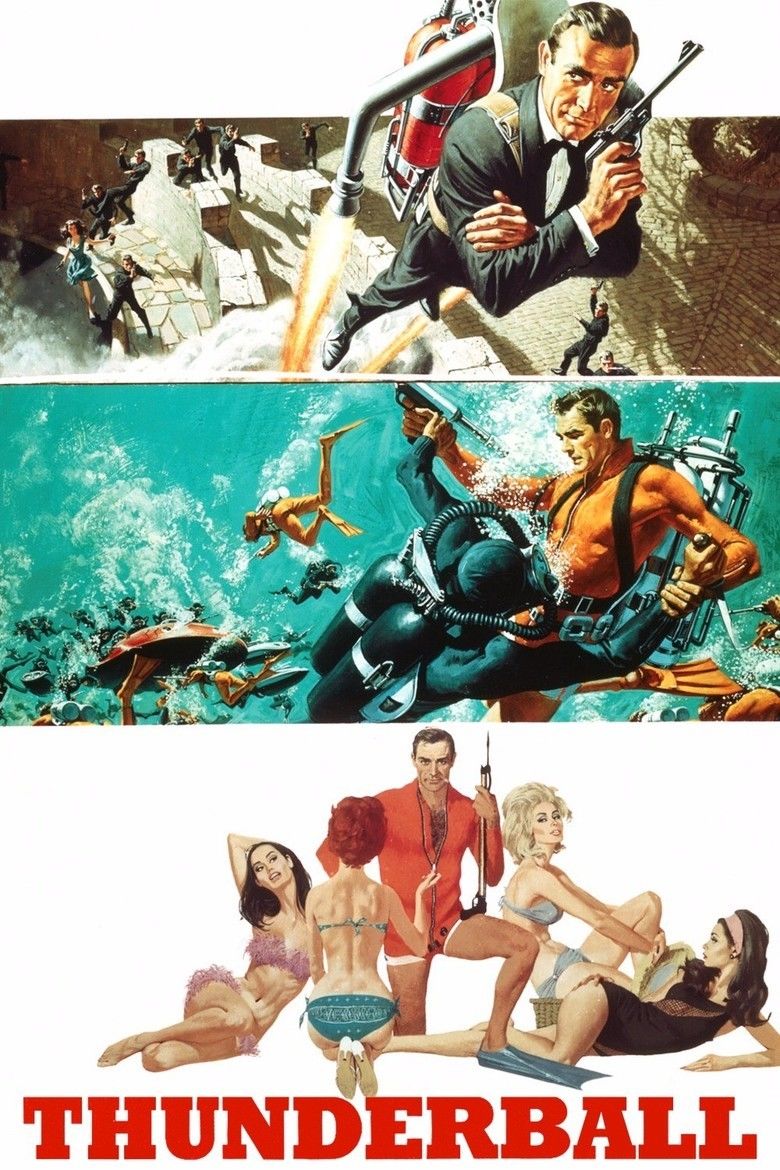 | ||||||||||||||||||||||||||||||||||
Release date 9 December 1965 (1965-12-09) (Tokyo, premiere)29 December 1965 (1965-12-29) (United Kingdom) Based on an original screenplay by Kevin McCloryJack WhittinghamIan Fleming Writer Richard Maibaum (screenplay), John Hopkins (screenplay), Jack Whittingham (original screenplay), Kevin McClory (original story), Jack Whittingham (original story), Ian Fleming (original story) Nominations BAFTA Award for Best British Art Direction (Colour) Cast (James Bond), (Dominique 'Domino' Derval), (Emilio Largo), (Fiona Volpe), (Felix Leiter), (Count Lippe) Similar movies Tagline Look up! Look down! Look out! | ||||||||||||||||||||||||||||||||||
Thunderball 1965 official trailer sean connery james bond movie hd
Thunderball (1965) is the fourth spy film in the James Bond series starring Sean Connery as the fictional MI6 agent James Bond. It is an adaptation of the novel of the same name by Ian Fleming, which in turn was based on an original screenplay by Jack Whittingham. It was directed by Terence Young, with its screenplay by Richard Maibaum and John Hopkins.
Contents
- Thunderball 1965 official trailer sean connery james bond movie hd
- Thunderball movie clip my sincere condolences 1965 hd
- Plot
- Cast
- Legal disputes
- Casting
- Filming
- Effects
- Music
- Release and reception
- Contemporary reviews
- Reflective reviews
- References
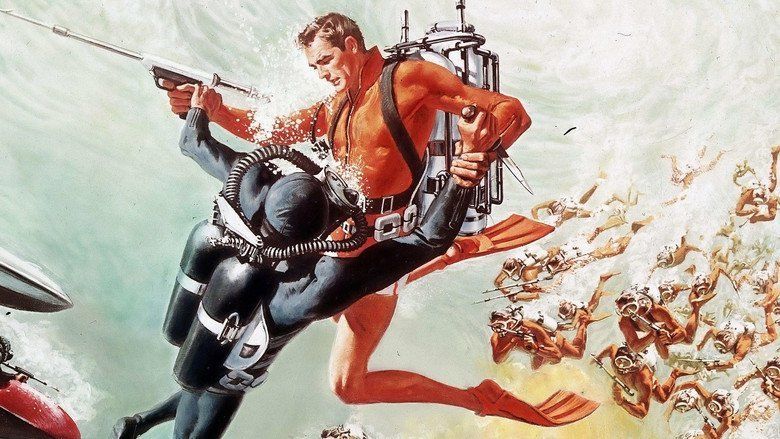
The film follows Bond's mission to find two NATO atomic bombs stolen by SPECTRE, which holds the world to ransom for £100 million in diamonds, in exchange for not destroying an unspecified major city in either England or the United States (later revealed to be Miami). The search leads Bond to the Bahamas, where he encounters Emilio Largo, the card-playing, eye patch-wearing SPECTRE Number Two. Backed by CIA agent Felix Leiter and Largo's mistress, Domino Derval, Bond's search culminates in an underwater battle with Largo's henchmen. The film had a complex production, with four different units and about a quarter of the film consisting of underwater scenes. Thunderball was the first Bond film shot in widescreen Panavision and the first to have running time of over two hours.
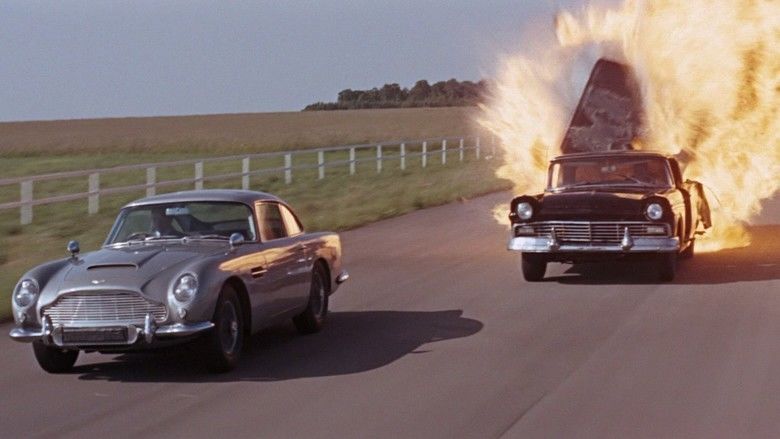
Thunderball was associated with a legal dispute in 1961 when former Ian Fleming collaborators Kevin McClory and Jack Whittingham sued him shortly after the 1961 publication of the novel, claiming he based it upon the screenplay the trio had earlier written in a failed cinematic translation of James Bond. The lawsuit was settled out of court and Bond film series producers Albert R. Broccoli and Harry Saltzman, fearing a rival McClory film, allowed him to retain certain screen rights to the novel's story, plot, and characters, and for McClory to receive sole producer credit on this film; Broccoli and Salzman were instead credited as Executive Producers.
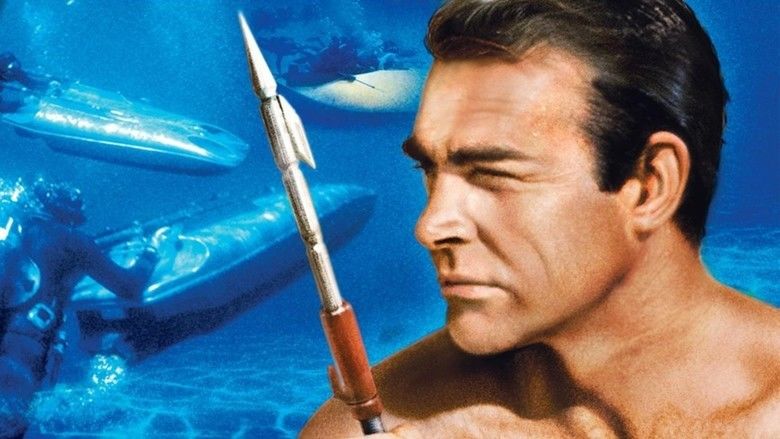
The film was a success, earning a total of $141.2 million worldwide, exceeding the earnings of the three previous Bond films. In 1966, John Stears won the Academy Award for Best Visual Effects and production designer Ken Adam was also nominated for a BAFTA award. Thunderball is the most financially successful film of the series when adjusting for ticket price inflation. Some critics and viewers showered praise on the film and branded it a welcome addition to the series, while others complained of the repetitively monotonous aquatic action and prolonged length. In 1983, Warner Bros. released a second film adaptation of the novel under the title Never Say Never Again, with McClory as executive producer.

Thunderball movie clip my sincere condolences 1965 hd
Plot
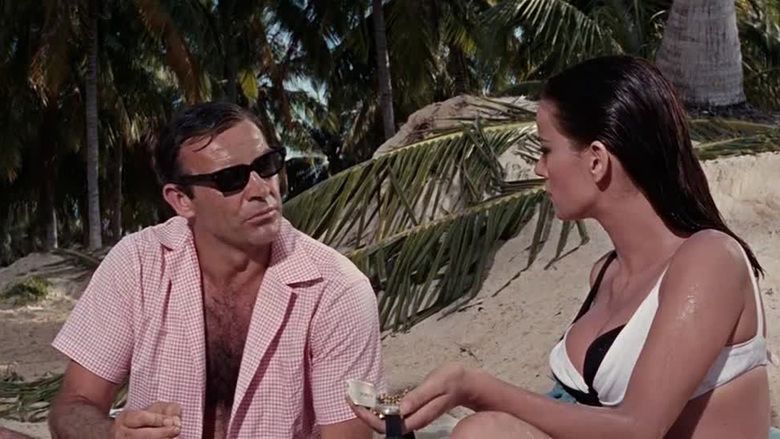
James Bond attends the funeral of Colonel Jacques Bouvar, a SPECTRE operative connected with the previous murders of two MI6 agents. Bouvar is alive and disguised as his own widow, but Bond identifies him. Pursuing Bouvar to his château, Bond fights and kills him, escaping with use of a jetpack and his Aston Martin DB5, conveniently driven up by French agent, Madame La Porte.
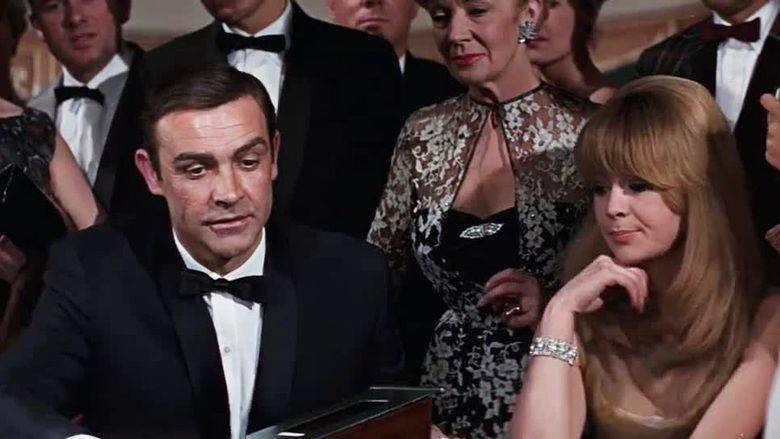
At a SPECTRE meeting in Paris, chaired by the enigmatic Number One, Emilio Largo (SPECTRE operative Number Two) introduces the group's latest project: hijacking two atomic bombs and holding NATO for ransom. The plot begins at the Shrublands sanatorium, located close to the NATO air base. Coincidentally, James Bond is at Shrublands to improve his health. There, he notices Count Lippe, an operative of SPECTRE with a Tong tattoo. Bond searches Lippe's room, but is seen leaving by Lippe's clinic neighbor, whose head is covered in bandages. Lippe tries to murder Bond with a spinal traction machine, but Bond is saved by his physiotherapist, Patricia Fearing, whom he then coerces into having sex.

Lippe and Angelo, the bandaged man, are part of SPECTRE'S plot. Angelo's face was surgically altered to match the appearance of François Derval, a French Air Force pilot slated to fly on a training mission aboard an RAF strategic jet bomber Avro Vulcan loaded with two atomic bombs. Derval is murdered by Angelo Palazzi, who then tries to extort more money for his services from SPECTRE. Agent Fiona Volpe seemingly acquiesces to his demands and he takes Derval's place on the flight. On the flight, Angelo gasses the remainder of the crew, hijacks the plane, and executes a controlled water landing near the Bahamas, submerging the jet. The atomic bombs are retrieved by SCUBA-equipped SPECTRE operatives, commanded by Largo. Angelo, trapped by his seat strapping, is killed by Largo for reneging on his original deal with SPECTRE. Meanwhile, Bond has uncovered Derval's corpse at the sanatorium. Bond is later attacked by Lippe, who is killed by a rocket-propelled grenade launched by a motorcycle as punishment for failing to foresee Angelo's greed. The motorcycle's fully masked rider later pushes it into the water, after which the rider is revealed to be Volpe as she had removed her leather mask, goggles, and gloves, and was removing her headgear.
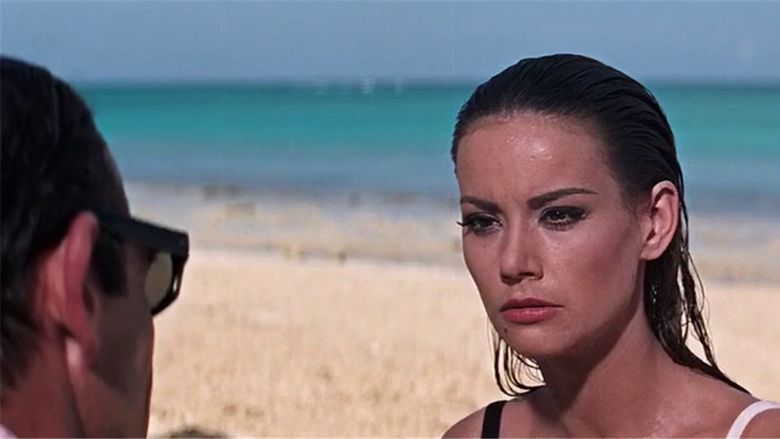
Back in London, at an MI6 conference, all of the 00 agents are informed that SPECTRE demands £100 million from NATO in exchange for returning the bombs and threatens to destroy a major city in the United States or the United Kingdom. At the meeting, Bond recognises Derval from a photograph. Bond requests M to be sent to Nassau, Bahamas, where Derval's sister, Domino, is staying.
While snorkelling, Bond meets Domino. Later, at a casino, he encounters Domino and Largo, who has taken Domino as his mistress. Bond enters a game against Largo and wins, and subsequently takes Domino to a dance. Bond and Largo recognise each other as adversaries and begin a tense cat-and-mouse game of attempting to gain advantage over each other while still pretending ignorance of their adversary's true nature. Bond meets Felix Leiter and Q, and is issued various gadgets, including an underwater infrared camera, a distress beacon, underwater breathing apparatus, a flare gun, and a Geiger counter. Diving under Largo's ship, the Disco Volante, Bond fails to find the atomic bomb, but detects an underwater hatch; Bond narrowly escapes Largo's henchmen. The next day, Bond visits Largo at his estate, Palmyra.
Bond is kidnapped by Fiona Volpe, but escapes through a Junkanoo celebration to the Kiss Kiss club, where Fiona is accidentally shot and killed by her own bodyguard. Bond and Felix search for the Vulcan, finding it under water. Bond tells Domino that Largo killed her brother and asks her for help in finding the bombs, giving her his Geiger counter. As she is looking for the bombs on board, she is discovered and tortured by Largo.
Meanwhile, Bond disguises himself as one of Largo's henchmen, and uncovers Largo's plan to destroy Miami Beach. Bond is discovered, but rescued by Leiter, who orders the United States Coast Guard to parachute to the area via U.S. Air Force transport aircraft. After an underwater battle, the henchmen surrender. Largo escapes to his ship, which has one of the bombs on board. Largo attempts to escape by jettisoning the rear of the ship, which is pursued by Royal Navy and U.S. Coast Guard vessels. During a fight on board, Largo is about to shoot Bond when Domino, freed by Largo's nuclear physicist Ladislav Kutze, kills Largo with a harpoon. Bond, Domino, and Kutze jump overboard, and the boat runs aground and explodes. A sky hook-equipped CIA B-17 aircraft then rescues Bond and Domino.
Cast
Legal disputes
Originally meant as the first James Bond film, Thunderball was the centre of legal disputes that began in 1961 and ran until 2006. Former Ian Fleming collaborators Kevin McClory and Jack Whittingham sued Fleming shortly after the 1961 publication of the Thunderball novel, claiming he based it upon the screenplay the trio had earlier written in a failed cinematic translation of James Bond. The lawsuit was settled out of court; McClory retained certain screen rights to the novel's story, plot, and characters. By then, Bond was a box-office success, and series producers Broccoli and Saltzman feared a rival McClory film beyond their control; they agreed to McClory's producer's credit of a cinematic Thunderball, with them as executive producers.
Later, in 1964, Eon producers Broccoli and Saltzman agreed with McClory to cinematically adapt the novel; it was promoted as "Ian Fleming's Thunderball". Yet, along with the official credits to screenwriters Richard Maibaum and John Hopkins, the screenplay is also identified as 'based on an original screenplay by Jack Whittingham' and as 'based on the original story by Kevin McClory, Jack Whittingham, and Ian Fleming'. To date, the novel has twice been adapted cinematically; the 1983 Jack Schwartzman-produced Never Say Never Again features Sean Connery as James Bond, but is not an Eon production.
Casting
Broccoli's original choice for the role of Domino Derval was Julie Christie following her performance in Billy Liar in 1963. Upon meeting her personally, however, he was disappointed and turned his attentions towards Raquel Welch after seeing her on the cover of the October 1964 issue of Life. Welch, however, was hired by Richard Zanuck of 20th Century Fox to appear in the film Fantastic Voyage the same year, instead. Faye Dunaway was also considered for the role and came close to signing for the part. Saltzman and Broccoli auditioned an extensive list of relatively unknown European actresses and models, including former Miss Italy Maria Grazia Buccella, Yvonne Monlaur of the Hammer horror films, and Gloria Paul. Eventually, former Miss France Claudine Auger was cast, and the script was rewritten to make her character French rather than Italian, although her lines were redubbed for the final cut. Nevertheless, director Young cast her once again in his next film, Triple Cross (1966). One of the actresses who tried for Domino, Luciana Paluzzi, later accepted the role as the redheaded femme fatale assassin Fiona Kelly, who originally was intended by Maibaum to be Irish. The surname was changed to Volpe in co-ordination with Paluzzi's nationality.
Filming
Guy Hamilton was invited to direct, but considered himself worn out and "creatively drained" after the production of Goldfinger. Terence Young, director of the first two Bond films, returned to the series. Coincidentally, when Saltzman invited him to direct Dr. No, Young expressed interest in directing adaptations of Dr. No, From Russia with Love and Thunderball. Years later, Young said Thunderball was filmed "at the right time", considering that if it was the first film in the series, the low budget (Dr. No cost only $1 million) would not have yielded good results. Thunderball was the final James Bond film directed by Young.
Filming commenced on 16 February 1965, with principal photography of the opening scene in Paris. Filming then moved to the Château d'Anet, near Dreux, France, for the fight in precredit sequence. Much of the film was shot in the Bahamas; Thunderball is widely known for its extensive underwater action scenes which are played out through much of the latter half of the film. The rest of the film was shot at Pinewood Studios, Buckinghamshire, Silverstone racing circuit for the chase involving Count Lippe, Fiona Volpe's RPG-armed BSA Lightning motorcycle and James Bond's Aston Martin DB5 before moving to Nassau, and Paradise Island in the Bahamas (where most of the footage was shot), and Miami. Huntington Hartford gave permission to shoot footage on his Paradise Island and is thanked at the end of the film.
On arriving in Nassau, McClory searched for locations to shoot many of the key sequences of the film and used the home of a local millionaire couple, the Sullivans, for Largo's estate, Palmyra. Part of the SPECTRE underwater assault was also shot on the coastal grounds of another millionaire's home on the island. The most difficult sequences to film were the underwater action scenes; the first to be shot underwater was at a depth of 50 feet to shoot the scene where SPECTRE divers remove the atomic bombs from the sunken Vulcan bomber. Peter Lamont had previously visited a Royal Air Force bomber station carrying a concealed camera which he used to get close-up shots of secret missiles (those appearing in the film were not actually present). Most of the underwater scenes had to be done at lower tides due to the sharks on the Bahamian coast.
After he read the script, Connery realised the risk of the sequence with the sharks in Largo's pool and insisted that production designer Ken Adam build a Plexiglas partition inside the pool. The barrier was not a fixed structure, so when one of the sharks managed to pass through it, Connery fled the pool, seconds away from attack. Ken Adam later told UK daily newspaper The Guardian,
"We had to use special effects, but unlike special effects today, they were real. The jet pack we used in Thunderball was real - it was invented for the United States Army. Bloody dangerous, and it only lasted a couple of minutes. The ejector seat in the Aston Martin was real and Emilio Largo's boat, the Disco Volante, was real. You had power boats at that time, but there were no good-sized yachts that were able to travel at 40 to 50 knots, so it was quite a problem. But by combining a hydrofoil, which we bought in Puerto Rico for $10,000, and a catamaran, it at least looked like a big yacht. We combined the two hulls with a one-inch slip bolt and when they split it worked like a dream. We used lots of sharks for this movie. I'd rented a villa in the Bahamas with a saltwater pool which we filled with sharks and used for underwater filming. The smell was horrendous. This was where Sean Connery came close to being bitten. We had a plexiglass corridor to protect him, but I didn't have quite enough plexiglass and one of the sharks got through. He never got out of a pool faster in his life - he was walking on water."
When special-effects coordinator John Stears provided a supposedly dead shark to be towed around the pool, the shark, which was still alive, revived at one point. Due to the dangers on the set, stuntman Bill Cummings demanded an extra fee of £250 to double for Largo's sidekick Quist as he was dropped into the pool of sharks.
The climactic underwater battle was shot at Clifton Pier and was choreographed by Hollywood expert Ricou Browning, who had worked on Creature From the Black Lagoon in 1954 and other films. He was responsible for the staging of the cave sequence and the battle scenes beneath the Disco Volante and called in his specialist team of divers who posed as those engaged in the onslaught. Voit provided much of the underwater gear in exchange for product placement and film tie-in merchandise. Lamar Boren, an underwater photographer, was hired to shoot all of the sequences. United States Air Force Lieutenant Colonel Charles Russhon, who had already established Eon productions' rapports with the local authorities in Turkey for From Russia with Love (1963) and at Fort Knox for Goldfinger (1964), supplied the experimental rocket fuel used to destroy the Disco Volante. Russhon, using his position, was also able to gain access to the United States Navy's Fulton surface-to-air recovery system, used to lift Bond and Domino from the water at the end of the film. Filming ceased in May 1965, and the final scene shot was the physical fight on the bridge of the Disco Volante.
While in Nassau, during the final shooting days, special-effects supervisor John Stears was supplied experimental rocket fuel to use in exploding Largo's yacht. Ignoring the true power of the volatile liquid, Stears doused the entire yacht with it, took cover, and then detonated the boat. The resultant massive explosion shattered windows along Bay Street in Nassau roughly 30 miles away. Stears went on to win an Academy Award for his work on Thunderball.
As the filming neared its conclusion, Connery had become increasingly agitated with press intrusion and was distracted with difficulties in his marriage of 32 months to actress Diane Cilento. Connery refused to speak to journalists and photographers who followed him in Nassau, stating his frustration with the harassment that came with the role; "I find that fame tends to turn one from an actor and a human being into a piece of merchandise, a public institution. Well, I don't intend to undergo that metamorphosis." In the end he, gave only a single interview, to Playboy, as filming was wrapped up, and even turned down a substantial fee to appear in a promotional TV special made by Wolper Productions for NBC The Incredible World of James Bond. According to editor Peter R. Hunt, Thunderball's release was delayed for three months, from September until December 1965, after he met David Picker of United Artists, and convinced him it would be impossible to edit the film to a high enough standard without the extra time.
Effects
Thanks to special-effects man John Stears, Thunderball's pretitle teaser, the Aston Martin DB5 (introduced in Goldfinger), reappears armed with rear-firing water cannon, seeming noticeably weathered – just dust and dirt, raised moments earlier by Bond's landing with the Bell Rocket Belt (developed by Bell Aircraft Corporation). The rocket belt Bond uses to escape the château actually worked, and was used many times, before and after, for entertainment, most notably at Super Bowl I and at scheduled performances at the 1964–1965 New York World's Fair.
Bond receives a spear gun-armed underwater jet pack scuba (allowing the frogman to manoeuvre faster than other frogmen). Designed by Jordan Klein, green dye was meant to be used by Bond as a smoke screen to escape pursuers. Instead Ricou Browning, the film's underwater director, used it to make Bond's arrival more dramatic.
The sky hook used to rescue Bond at the end of the film was a rescue system used by the United States military at the time. At Thunderball's release, there was confusion as to whether a rebreather such as the one that appears in the film existed; most Bond gadgets, while implausible, often are based upon real technology. In the real world, a rebreather could not be so small, as it has no room for the breathing bag, while the alternative open-circuit scuba releases exhalation bubbles, which the film device does not. It was made with two CO2 bottles glued together and painted, with a small mouthpiece attached. For this reason, when the Royal Corps of Engineers asked Peter Lamont how long a man could use the device underwater, the answer was "As long as you can hold your breath."
Maurice Binder was hired to design the title sequence, and was involved in a dispute with Eon Production to have his name credited in the film. As Thunderball was the first James Bond film shot in Panavision, Binder had to reshoot the iconic gun barrel scene which permitted him to not only incorporate pinhole photographic techniques to shoot inside a genuine gun barrel, but also made Connery appearing in the sequence for the first time a reality, as stunt man Bob Simmons had doubled for him in the three previous films. Binder gained access to the tank at Pinewood which he used to film the silhouetted title girls who appeared naked in the opening sequence, which was the first time actual nudity (although concealed) had ever been seen in a Bond film.
On 26 June 2013, Christie's auction house sold the Breitling SA Top Time watch worn in the film by Connery for over £100,000; given to Bond by Q, it was also a Geiger counter in the plot.
Music
Thunderball was the third James Bond score composed by John Barry, after From Russia with Love and Goldfinger. The original title song was entitled "Mr. Kiss Kiss, Bang Bang", taken from an Italian journalist who in 1962 dubbed agent 007 as Mr. Kiss Kiss, Bang Bang. The title theme was written by Barry and Leslie Bricusse; the song was originally recorded by Shirley Bassey, and later rerecorded by Dionne Warwick, whose version was not released until the 1990s. The song was removed from the title credits after producers Albert R. Broccoli and Harry Saltzman were worried that a theme song to a James Bond film would not work well if the song did not have the title of the film in its lyrics. Barry then teamed up with lyricist Don Black and wrote "Thunderball", which was sung by Tom Jones, who according to Bond production legend, fainted in the recording booth when singing the song's final note. Jones said of it, "I closed my eyes and I held the note for so long when I opened my eyes the room was spinning."
Country musician Johnny Cash also submitted a song to Eon productions titled "Thunderball", but it went unused.
Release and reception
The film premiered on 9 December 1965 in Tokyo and opened on 29 December 1965 in the UK. It was a major success at the box office with record-breaking earnings. Variety reported that Thunderball was the number-one money maker of 1966 at the North American box office by a large margin, with a net profit of $26,500,000. The second-highest money maker of 1966 was Doctor Zhivago at $15,000,000; in third place was Who's Afraid of Virginia Woolf? at $10,300,000. It eventually grossed $63.6 million in the United States, equating to roughly 58.1 million admissions. In total, the film has earned $141.2 million worldwide, surpassing the earnings of the three preceding films in the series—easily recouping its $9 million budget—and remained the highest-grossing Bond film until Live and Let Die (1973) assumed the record. After adjusting its earnings to 2011 prices, it has made around $1 billion, making it the second-most financially successful Bond film after Skyfall.
Thunderball won an Academy Award for Best Visual Effects awarded to John Stears in 1966. Ken Adam the production director was also nominated for a Best Production Design BAFTA award. The film won the Golden Screen Award in Germany and the Golden Laurel Action Drama award at the 1966 Laurel Awards. The film was also nominated for an Edgar Best Foreign Film award at the Edgar Allan Poe Awards.
Contemporary reviews
Upon its release, the film received generally positive reviews. Dilys Powell of The Sunday Times remarked after seeing the film that "The cinema was a duller place before 007." David Robinson of The Financial Times criticised the appearance of Connery and his effectiveness to play Bond in the film, remarking: "It's not just that Sean Connery looks a lot more haggard and less heroic than he did two or three years ago, but there is much less effort to establish him as connoisseur playboy. Apart from the off-handed order for Beluga, there is little of that comic display of bon viveur-manship that was one of the charms of Connery's almost-a-gentleman 007."
Reflective reviews
According to Danny Peary, Thunderball "takes forever to get started and has too many long underwater sequences during which it's impossible to tell what's going on. Nevertheless, it's an enjoyable entry in the Bond series. Sean Connery is particularly appealing as Bond – I think he projects more confidence than in other films in the series. Film has no great scene, but it's entertaining as long as the actors stay above water."
Critics such as James Berardinelli praised Connery's performance, the femme fatale character of Fiona Volpe, and the underwater action sequences, remarking that they were well choreographed and clearly shot. He criticised the length of the scenes, however, stating they were in need of editing, particularly during the film's climax. At Rotten Tomatoes, the film received an 86% rating. In 2014 Time Out polled several film critics, directors, actors, and stunt actors to list their top action films; Thunderball was listed at number 73.
References
Thunderball (film) WikipediaThunderball (film) IMDbThunderball (film) Rotten TomatoesThunderball (film) themoviedb.org
